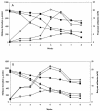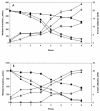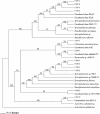Syntrophic-methanogenic associations along a nutrient gradient in the Florida Everglades
- PMID: 15184146
- PMCID: PMC427755
- DOI: 10.1128/AEM.70.6.3475-3484.2004
Syntrophic-methanogenic associations along a nutrient gradient in the Florida Everglades
Abstract
Nutrient runoff from the Everglades Agricultural Area resulted in a well-documented gradient of phosphorus concentrations in soil and water, with concomitant ecosystem-level changes, in the northern Florida Everglades. It was recently reported that sulfate-reducing prokaryote assemblage composition, numbers, and activities are dependent on position along the gradient (H. Castro, K. R. Reddy, and A. Ogram, Appl. Environ. Microbiol. 68:6129-6137, 2002). The present study utilized a combination of culture- and non-culture-based approaches to study differences in composition of assemblages of syntrophic and methanogenic microbial communities in eutrophic, transition, and oligotrophic areas along the phosphorus gradient. Methanogenesis rates were much higher in eutrophic and transition regions, and sequence analysis of 16S rRNA gene clone libraries constructed from samples taken from these regions revealed differences in composition and activities of syntroph-methanogen consortia. Methanogens from eutrophic and transition regions were almost exclusively composed of hydrogenotrophic methanogens, with approximately 10,000-fold-greater most probable numbers of hydrogenotrophs than of acetotrophs. Most cultivable strains from eutrophic and transition regions clustered within novel lineages. In non-culture-based studies to enrich syntrophs, most bacterial and archaeal clones were either members of novel lineages or closely related to uncultivated environmental clones. Novel cultivable Methanosaeta sp. and fatty acid-oxidizing bacteria related to the genera Syntrophomonas and Syntrophobacter were observed in microcosms containing soil from eutrophic regions, and different lines of evidence indicated the existence of novel syntrophic association in eutrophic regions.
Figures







References
-
- Altschul, S. F., W. Gish, W. Miller, E. W. Myers, and D. J. Lipman. 1990. Basic local alignment search tool. J. Mol. Biol. 215:403-410. - PubMed
-
- Bachoon, D., and R. D. Jones. 1992. Potential rates of methanogenesis in sawgrass marshes with peat and marl soils in the Everglades. Soil Biol. Biochem. 24:21-27.
-
- Burggraf, S., K. O. Stetter, P. Rouviere, and C. R. Woese. 2001. Methanopyrus kandleri: an archaeal methanogen unrelated to all other known methanogens. Syst. Appl. Microbiol. 14:346-351. - PubMed
-
- Cicerone, R. J., and R. S. Oremland. 1988. Biogeochemical aspects of atmospheric methane. Global Biogeochem. Cycles 2:299-327.
Publication types
MeSH terms
Substances
Associated data
- Actions
- Actions
- Actions
- Actions
- Actions
- Actions
- Actions
- Actions
- Actions
- Actions
- Actions
- Actions
- Actions
- Actions
- Actions
- Actions
- Actions
- Actions
- Actions
- Actions
- Actions
- Actions
- Actions
- Actions
- Actions
- Actions
LinkOut - more resources
Full Text Sources
Molecular Biology Databases

